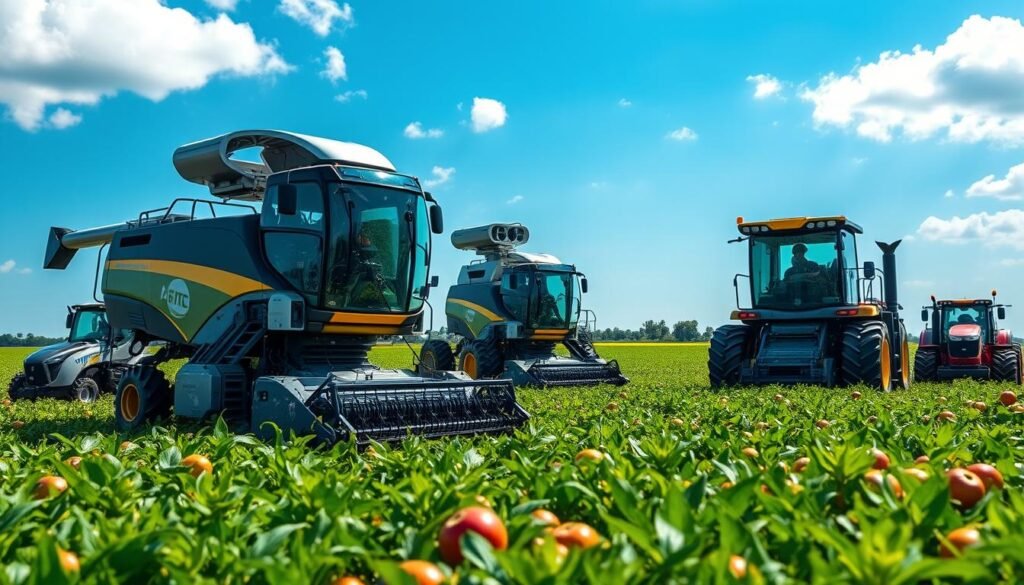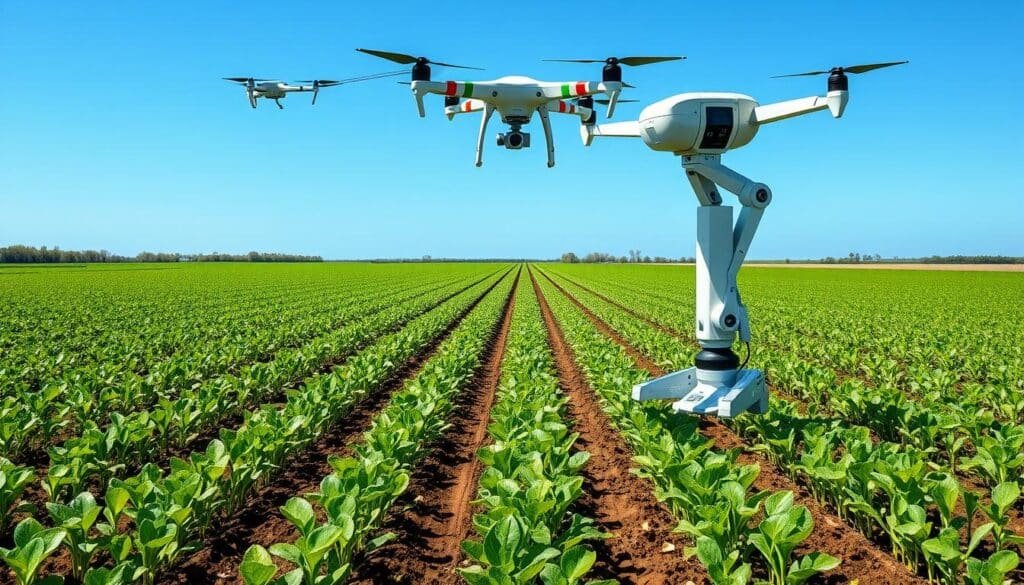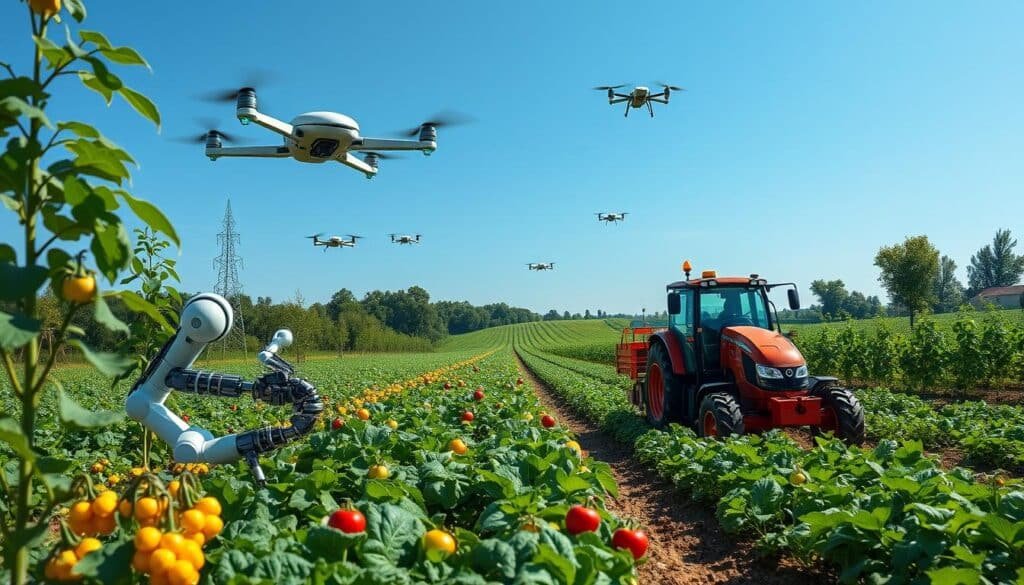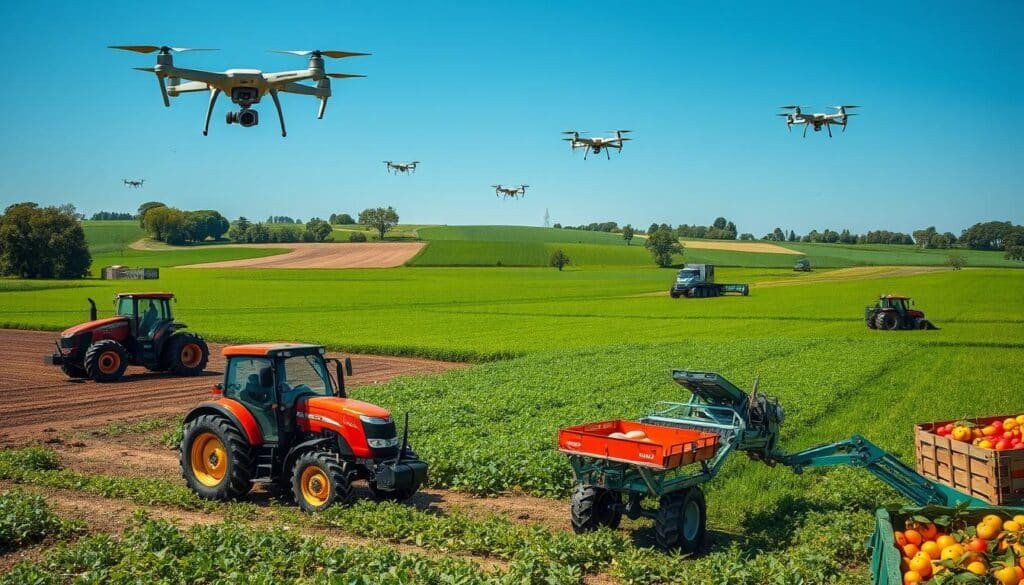The world’s population is growing fast, expected to hit 9.7 billion by 2050. This puts a lot of pressure on farming to produce more food. Old farming ways can’t keep up because of labor shortages, environmental worries, and not being efficient enough. Robotics and automation in farming could be the answer, helping farmers work smarter, protect the environment, and ensure everyone has enough to eat.
Agricultural robots are changing farming for the better. They help with everything from planting to picking crops. These robots use advanced tech to work more accurately and efficiently, helping solve big problems like food shortages and climate change.
Using robots in farming can make crops better and save money. It also helps reduce the harm farming can do to the environment. With big investments in ag-tech in 2022, the future of farming robots looks bright. It’s a hopeful sign for feeding the world’s growing population.
Key Takeaways
- Robotics and automation address the challenges of food production, environmental impact, and labor shortages in agriculture.
- Agricultural robots perform tasks such as precision farming, autonomous plowing, weeding, and harvesting.
- Benefits of agricultural robotics include increased efficiency, reduced environmental impact, cost savings, and data-driven insights.
- Challenges include high initial costs, technical complexities, and data security concerns.
- The global population is expected to reach 9.7 billion by 2050, driving the need for innovative solutions in agriculture.
The Agricultural Revolution: Meeting Global Food Demands
The world’s population is growing fast, making it crucial to find new ways to farm. Old farming methods can’t keep up with the demand for food. Problems like soil damage, too much water use, and chemicals show we need a change.
Current Challenges in Traditional Farming
Traditional farming faces big challenges. Soil health is suffering from too much use and chemicals. Water is also a big issue, with farming using a lot of it. Plus, the use of pesticides harms the environment, pushing us towards better ways.
Population Growth and Food Security Concerns
The UN says we’ll have 9.7 billion people by 2050. This growth, along with changing diets, puts a lot of pressure on food systems. We need new ways to feed everyone, ensuring everyone has enough to eat.
Environmental Impact of Conventional Agriculture
Conventional farming’s impact on the environment is a big worry. It leads to more greenhouse gases, soil loss, and less biodiversity. This has led to a search for farming methods that are better for the planet.
The farming world is changing, with technology like robots and automation leading the way. These tools help solve old problems and make farming more efficient. They aim to feed the world while protecting the environment.
| Metric | Current Conventional Farming | Robotic Farming |
|---|---|---|
| Herbicide Usage | High | Reduced by up to 90% |
| Productivity | Limited by labor and weather constraints | Increased through continuous 24-hour operation |
| Precision | Relies on manual techniques | Optimized through GPS guidance and machine vision |
| Environmental Impact | High greenhouse gas emissions, soil degradation | Reduced chemical usage and resource conservation |
Understanding Agricultural Robotics and Automation

The world of agriculture is changing fast, thanks to robotics and automation. Agricultural robots use advanced sensors, GPS, and AI to change how we watch crops, analyze soil, and manage resources.
Precision agriculture is key to this change. Robots collect lots of data in real-time. This helps farmers make better choices and work more efficiently. From tractors to drones, these technologies are changing farming.
The use of AI in farming and autonomous systems has started a new era of smart farming. Farmers now make decisions based on data. This leads to better crops and less harm to the environment.
| Agricultural Robot Type | Price Range | Key Features |
|---|---|---|
| Autonomous Tractors | $400,000 – $700,000 | GPS-guided navigation, autonomous operation, advanced sensors |
| Harvesting Robots | $100,000 – $500,000 | Precision picking, high accuracy rates, reduced labor costs |
| Monitoring Drones | $800 – $50,000 | Aerial data collection, crop monitoring, land surveying |
Using agricultural robots and automation comes with challenges. The cost is high at first, but it saves money and resources in the long run. As technology gets better and cheaper, farming will see big changes.
Robots and AI are changing how we grow food. They help farmers work better, protect the environment, and meet the world’s food needs.
Essential Types of Agricultural Robots

The world of agriculture is changing fast, thanks to new robotics and automation. We see everything from self-driving tractors to drones and weeding robots. These technologies help farmers work smarter, grow more food, and solve big problems.
Autonomous Tractors and Heavy Machinery
Autonomous tractors, like the Dot Power Platform, are changing farming. They use GPS and maps to do jobs like plowing and seeding. These autonomous tractors work all day, every day, making farming more efficient and saving money.
Harvesting and Picking Robots
Robots are now picking crops for farmers. Abundant Robotics’ fruit-picking robots use computer vision to pick fruit carefully. They’re very good at it, even better than people.
Harvest CROO’s strawberry-picking robot can pick a plant in eight seconds. It then moves to the next one in just over a minute. These robots are amazing at their job.
Monitoring and Analysis Drones
Agricultural drones with special sensors are changing how farms are managed. They take pictures that show how plants are doing, helping farmers decide on water and fertilizer. American Robotics’ Scout drone is a great example of this technology.
Robots in farming are starting a new era of precision. They help farmers use resources better, save money, and grow food in a way that’s good for the planet.
Precision Agriculture Through Robotics

Precision farming uses real-time data and advanced tech to improve farming. Robotic systems are key in making farming more efficient, sustainable, and productive.
Robots help farmers check soil, monitor crops, and apply inputs accurately. Autonomous tractors with sensors and GPS make tasks like plowing and planting more efficient. Robotic harvesters use computer vision to pick ripe fruits and veggies, making harvesting easier.
Weeding robots with AI help farmers grow crops without harming the environment. They target weeds carefully, saving water, fertilizers, and pesticides. This leads to better crop yields and smarter use of resources.
Robots collect data for farmers to make better decisions on water, fertilizers, and pest control. This approach can help feed more people and reduce environmental harm.
Even though precision farming is beneficial, it’s not yet widely used. High costs and training needs are barriers. But, success stories show it can increase yields and save money while being kinder to the planet.
As robotics in farming gets better, the future looks bright. Farmers will have access to more advanced robots. This will help feed more people and protect the environment.
“By 2050, agricultural production, particularly field agriculture, must increase by 70% to cater to a global population predicted to exceed 9 billion people.”
Benefits and Economic Impact of Agricultural Robotics

Robots in agriculture are changing the game, offering more than just better agricultural productivity. They make farming more efficient, support sustainable farming, and improve crop yields. This all leads to big economic benefits.
Cost Efficiency and Labor Management
Robotic farming systems work non-stop, saving on labor costs. They can do tasks like seeding and harvesting with precision. This makes farming cheaper and more efficient, helping farmers’ bottom line.
Environmental Sustainability
Robots help make farming greener. They apply fertilizers and water exactly where needed, cutting waste. This not only boosts crop quality but also protects the environment.
Improved Crop Yields and Quality
Robots bring data-driven insights to farming, leading to better crop yields and quality. They monitor plant health and soil conditions, ensuring crops grow well. This results in higher-quality produce and more money for farmers.
| Benefit | Impact |
|---|---|
| Cost Efficiency and Labor Management | Reduced labor costs, increased productivity, and improved operational efficiency. |
| Environmental Sustainability | Precise resource management, reduced waste, and a smaller environmental footprint. |
| Improved Crop Yields and Quality | Higher-quality produce, increased agricultural productivity, and greater economic returns. |
“By 2050, the world is forecasted to need to produce 56% more food than it did in 2010 to nourish the growing global population.”
Adopting agricultural robotics is key to meeting the world’s food needs sustainably. It promises a brighter, more economically viable future for farming.
Challenges and Future Developments in Agricultural Robotics

Agricultural robotics and automation are changing how we grow food. But, there are big challenges to overcome before they can be used everywhere.
One big problem is the cost of these systems. They are expensive, making it hard for small farmers to afford them. New ways to pay for these technologies, like “Robotics-as-a-Service,” might help.
Developing robots that can work in different farming settings is tough. Robots need to adapt to many types of crops, terrains, and weather. They also have to work well with how farmers already farm, which takes time and effort.
Data security is another big issue. Keeping information like crop health and farming methods safe is key. It helps build trust and protects the future of farming.
The future of farming with robots looks very promising. New tech like artificial intelligence and sensors will make robots smarter and more capable. This will make farming more efficient, productive, and green, shaping the future of agriculture.
“Embracing agricultural robots can lead to a more sustainable and efficient future for agriculture.”
The role of robots in farming will grow as the industry faces challenges like labor shortages and environmental issues. By solving these problems, farming can become more productive, green, and secure.
Also Read : Digital Transformation: Your Guide To Business Success
Conclusion
Robotics in agriculture is a big step forward for sustainable farming. It’s changing how we grow food. With the world’s population growing, we need more food. Robotics help meet this need.
Robotics have come a long way. They’ve moved from simple arms to complex systems. These systems can do many tasks well, like driving tractors and picking crops. They also help us watch over our crops better.
As technology gets better and cheaper, we’ll see more robots in farming. They will work with people to make farming better. This mix of human skill and robot power will help us grow food in a way that’s good for the planet.
FAQs
Q: What is the future of robotics in agriculture?
A: The future of robotics in agriculture is promising, with advancements in artificial intelligence and automation solutions leading to more efficient farming practices. Robotics applications are expected to increase productivity and reduce labor costs while addressing food security challenges.
Q: What are the common types of robots used in agriculture?
A: Common types of robots in agriculture include autonomous mobile robots, robotic arms, and collaborative robots (cobots). These robots are designed to perform a variety of tasks such as planting, harvesting, and monitoring crops.
Q: What are the pros and cons of robotics in agriculture?
A: The pros of robotics in agriculture include increased efficiency, reduced labor costs, and the ability to perform repetitive tasks with precision. However, the cons may include high initial investment costs and a potential loss of jobs in traditional farming roles.
Q: How does artificial intelligence play a role in agricultural robotics?
A: Artificial intelligence enhances robotics by enabling machines to analyze data from sensors and make decisions in real-time. This capability allows for better crop management and optimization of resources, leading to improved yields.
Q: Can you explain the history of robotics in agriculture?
A: The history of robotics in agriculture dates back to the early 20th century with the development of mechanized equipment. Over the years, advancements in engineering and computer science have led to more sophisticated robots that can perform complex agricultural tasks.
Q: What types of robotics are used in warehouse automation?
A: In warehouse automation, various types of robots are utilized, including mobile robots for inventory management and robotic arms for picking and packing. These automation solutions improve efficiency and accuracy in warehouse operations.
Q: What are the robotics aspects that farmers should consider?
A: Farmers should consider several robotics aspects, including the types of robots available, their compatibility with existing farming equipment, the ease of programming, and the potential return on investment for automation solutions.
Q: How do sensors contribute to the effectiveness of agricultural robots?
A: Sensors play a crucial role by providing real-time data on soil conditions, crop health, and environmental factors. This information helps robots make informed decisions, enhancing their efficiency and effectiveness in agricultural tasks.
Q: What types of robots are typically seen in the agricultural robotics industry?
A: The agricultural robotics industry typically features a variety of robots, including industrial robots for large-scale operations, mobile robots for precision farming, and humanoid robots designed for specific rehabilitation tasks in agriculture.

